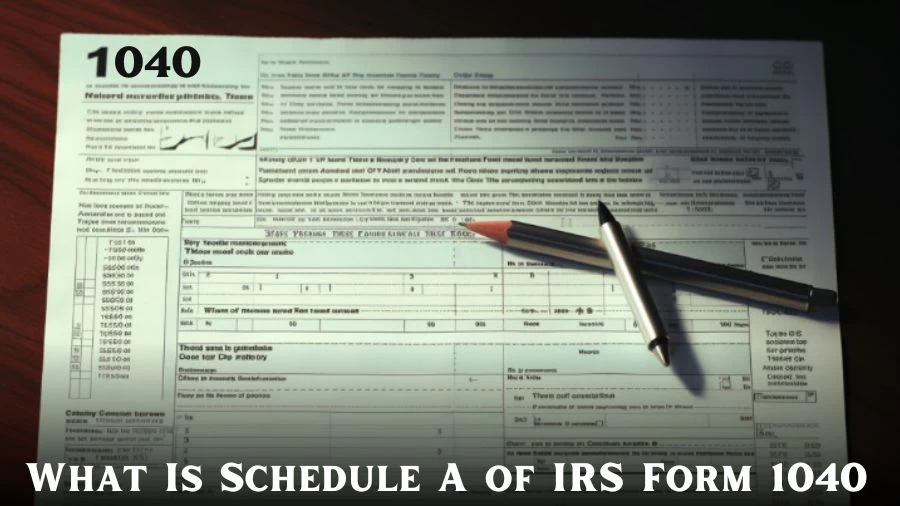
What is Schedule A of IRS Form 1040? What Items Can Be Deducted on Schedule A?
Schedule A of IRS Form 1040 is an attachment that allows taxpayers to itemize deductible expenses rather than taking the standard deduction, potentially reducing their taxable income for greater tax savings.
by Kowsalya
Updated Aug 30, 2023
On This Page
What is Schedule A of IRS Form 1040?
Schedule A is an attachment to IRS Form 1040 (U.S. Individual Income Tax Return) that allows taxpayers to itemize their deductions rather than taking the standard deduction. It's used by individuals who have eligible expenses that exceed the standard deduction amount and want to maximize their potential tax savings by reporting these specific deductions.
On Schedule A, taxpayers can list various deductible expenses across different categories, such as medical and dental expenses, taxes paid (state and local income taxes, property taxes), interest paid (mortgage interest, investment interest), charitable contributions, casualty and theft losses (if incurred in federally-declared disaster areas), and other miscellaneous deductions.
The total of these itemized deductions is then subtracted from the taxpayer's adjusted gross income (AGI), reducing their taxable income. If the total itemized deductions exceed the standard deduction amount for their filing status, it can result in a lower tax liability.
It's important to note that not all taxpayers will benefit from itemizing. Some taxpayers might find that their eligible deductions don't exceed the standard deduction, making it more advantageous for them to claim the standard deduction instead.
The specific eligibility criteria, rules, and limitations for each type of deduction can change over time due to updates in tax laws and regulations. Therefore, it's recommended to consult the most current IRS guidelines or seek professional tax advice when filling out Schedule A.
What Items Can Be Deducted on Schedule A?
Items Eligible for Deduction on Schedule A
Schedule A (Form 1040 or 1040-SR) serves as a platform for taxpayers to itemize a range of deductions, enhancing their potential for tax savings. Here's an in-depth look at the items that can be deducted on Schedule A:
- Medical and Dental Expenses: Eligible medical and dental expenses are deductible if they exceed 10% of your Adjusted Gross Income (AGI). These expenses include costs related to medical treatments, prescriptions, surgeries, dental care, and more.
- State and Local Taxes: Taxpayers can deduct state and local income or sales taxes, real estate taxes, and personal property taxes. The total deduction for all state and local taxes combined is limited to $10,000.
- Mortgage and Home Equity Loan Interest: Interest on mortgages taken out after December 15, 2017, is deductible on the first $750,000 of mortgage debt. Older mortgages, established before this date, are subject to the previous $1 million limit. It's important to note that interest on home equity loans, if not utilized for substantial home improvements, is no longer deductible.
- Charitable Contributions: Contributions made to qualified charitable organizations can be deducted up to 60% of your AGI, up from the previous limit of 50%. This deduction encompasses both monetary donations and donations of goods.
- Casualty and Theft Losses: Deductions for personal casualty and theft losses are now limited to losses incurred within federally declared disaster areas. Business-related casualty and theft losses reported on appropriate business forms remain deductible.
- Job-Related Expenses and Certain Miscellaneous Deductions: Under prior tax laws, taxpayers could claim various job-related expenses and other miscellaneous deductions subject to the 2% of AGI limit. However, these deductions have been eliminated in recent tax reforms.
- Unreimbursed Employee Expenses: Expenses that were once eligible under the category of unreimbursed employee expenses, such as job-related travel, uniforms, and job education costs, are no longer deductible due to tax law changes.
- Tax Preparation Fees: Previously deductible tax preparation fees have also been eliminated as part of the tax law changes.
- Foreign Real Property Taxes: Deductions for foreign real property taxes are no longer allowed on Schedule A.
- Other Itemized Deductions: There are additional deductions that fall under the "other itemized deductions" category. However, due to the changes in tax laws, these are limited in number and should be reviewed based on the most current IRS guidelines.
As tax laws and regulations evolve, it's important to stay informed about the specific eligibility criteria, limits, and updates for each itemized deduction. To ensure accurate reporting and maximize your potential tax benefits, consider consulting professional tax advisors or referring to the latest IRS documentation when claiming deductions on Schedule A.
Who Can File Schedule A?
The Schedule A Form, designed for U.S. taxpayers, offers the option to pursue itemized deductions as an alternative to selecting the standard deduction. This choice is made based on whichever avenue yields greater tax advantages.
Allowable deductions encompass various categories, such as qualified medical expenses, a portion of state and local taxes, mortgage interest, specific sales tax payments, and particular charitable contributions.
For the 2022 tax year, the standard deduction stands at $12,950 for single taxpayers and those married but filing separately. For married couples choosing to file jointly, the standard deduction is $25,900, while heads of households enjoy a standard deduction of $19,400.
In the subsequent tax year, 2023, adjustments have been made. The standard deduction alters to $13,850 for single taxpayers and married individuals filing separately. Married couples opting for joint filing encounter a standard deduction of $27,700, whereas heads of households benefit from a standard deduction of $20,800.
Notably, numerous taxpayers who once opted for itemized deductions using Schedule A have shifted to claiming the standard deduction. This change in approach can be attributed to the Tax Cuts and Jobs Act of 2017, which implemented a cap on the deduction amount for state and local taxes. This limit is set at a maximum of $10,000 for married couples, and $5,000 for those married but filing separately. The legislation significantly increased the previous standard deduction, prompting this shift in taxpayer preference.
What is Schedule A in US Tax?
Schedule A, an official document issued by the Internal Revenue Service (IRS), serves as a means for taxpayers to assert their itemized deductions during the annual tax filing process. This form is completed and submitted alongside or electronically with Form 1040, the standard U.S. Individual Income Tax Return. The official designation of IRS Schedule A is "Itemized Deductions."
When it's time to fulfill your tax obligations, you engage with Schedule A to detail the specific itemized deductions you intend to claim. This crucial form allows you to present a comprehensive breakdown of deductible expenses that you are eligible to offset against your taxable income. Through this process, you aim to potentially reduce your tax liability and enhance your overall tax situation.
As part of your tax return documentation, you accurately complete the Schedule A form, providing a thorough account of your itemized deductions. This meticulous compilation is then either attached physically to your Form 1040 or submitted electronically, depending on your preferred filing method.
The primary purpose of IRS Schedule A, aptly titled "Itemized Deductions," is to ensure transparency and accuracy in the process of claiming tax-deductible expenses. By utilizing this form, taxpayers can effectively demonstrate their entitlement to deductions while complying with IRS regulations and guidelines. This collaborative approach between Form 1040 and Schedule A offers a comprehensive view of your financial landscape to the IRS, ensuring that the appropriate deductions are applied to your tax liability calculation.
What is Not Deductible on Schedule A?
While Schedule A allows taxpayers to itemize various deductible expenses to reduce their taxable income, there are certain expenses that cannot be claimed as itemized deductions. These non-deductible expenses include:
- Federal Income Taxes: You cannot deduct federal income taxes paid as an itemized deduction. However, you may be able to claim a deduction for state and local income taxes or general sales taxes paid, which are listed under the "Taxes You Paid" section of Schedule A.
- Social Security and Medicare Taxes: Payroll taxes for Social Security (FICA) and Medicare (Medicare tax) are not deductible on Schedule A. These taxes fund the Social Security and Medicare programs and are withheld from your earnings.
- Federal Unemployment (FUTA) Taxes: Federal Unemployment Tax Act (FUTA) taxes, which fund unemployment benefits for workers who have lost their jobs, cannot be claimed as an itemized deduction.
- Railroad Retirement Taxes (RRTA): Similar to FUTA taxes, Railroad Retirement Taxes (RRTA) are not deductible on Schedule A. These taxes fund retirement and disability benefits for railroad workers.
- Customs Duties: Expenses paid for customs duties on imported goods are not eligible for deduction on Schedule A. Customs duties are taxes imposed by the government on imported goods.
- Federal Gift Taxes: Gift taxes paid to the federal government are not deductible on Schedule A. Gift taxes are typically paid by the giver of a gift and not by the recipient.
- Per Capita Taxes: Taxes that are levied on a per-person basis, such as certain local taxes, are not deductible on Schedule A.
- Foreign Real Property Taxes: Taxes paid to foreign countries on real property are generally not deductible on Schedule A.
It's important to note that while these specific expenses are not deductible on Schedule A, there might be other tax provisions or forms that allow for deductions or credits related to some of these expenses. Additionally, tax laws and regulations can change, so it's always a good idea to consult with a tax professional or the latest IRS guidelines to ensure accurate and up-to-date information when preparing your tax returns.
When considering whether to itemize deductions on Schedule A or take the standard deduction, it's crucial to understand the specific rules and guidelines to make informed decisions about maximizing your tax savings.
Who Gots Benefits From Filing Schedule A?
Residents of high-tax states may find the $10,000 cap on deductions for state and local taxes to be a critical factor in their decision-making process. In cases where a married couple residing in such a state is unable to identify an additional $14,000 in eligible deductions beyond the $10,000 limit, they are more likely to opt for the standard deduction.
Numerous taxpayers possess deductible expenses that fall short of the standard deduction threshold. As a result, they are spared the obligation of meticulously tracking their expenditures and gathering receipts. It's worth noting that itemized deductions are susceptible to scrutiny by the Internal Revenue Service (IRS), unlike the standard deduction which faces no such challenge.
When a taxpayer has substantial eligible expenses surpassing the standard deduction, opting to file Schedule A becomes a logical choice. Particularly, the mortgage interest on an upscale residence frequently serves as a practical gauge for determining the appropriate approach.
Should the annual mortgage interest outlined in the Mortgage Interest Statement (Form 1098) exceed the standard deduction, there exists a clear advantage in itemizing deductions on Schedule A. This strategic decision can contribute positively to one's overall tax position.
How to File Schedule A?
The instructions provided in Schedule A guide taxpayers on the identification of eligible deductible expenses and their respective placement on the form. For the tax year 2022, you can access the IRS Schedule A (Form 1040) by downloading it from the official IRS website.
Within Schedule A, taxpayers are required to document their deductible expenses under any or all of the six specified categories:
- Medical and Dental Expenses
- Taxes You Paid
- Interest You Paid
- Gifts to Charity
- Casualty and Theft Losses (only applicable if the property is situated in a federally-declared disaster area)
- Other Itemized Deductions
Similar to the standard deduction, the itemized deductions listed on Schedule A are deducted from the taxpayer's adjusted gross income (AGI) to calculate their taxable income. If you choose to itemize your deductions, it's essential to maintain comprehensive records of eligible expenses throughout the year. This includes retaining receipts, invoices, and images of canceled checks as evidence of your deductible expenditures.
What is Schedule A of IRS Form 1040-FAQs
1. What is Schedule A of IRS Form 1040?
Schedule A is an attachment to IRS Form 1040 (U.S. Individual Income Tax Return) that allows taxpayers to itemize their deductible expenses instead of taking the standard deduction.
2. How does Schedule A differ from taking the standard deduction?
Taxpayers have the option to either claim the standard deduction or itemize their deductions using Schedule A.
3. What expenses can be listed on Schedule A?
Taxpayers can list various deductible expenses, including medical and dental expenses, state and local income taxes, property taxes, mortgage interest, investment interest, charitable contributions, casualty and theft losses in federally-declared disaster areas, and other miscellaneous deductions.
4. How do I know if itemizing is beneficial for me?
You should compare the total of your itemized deductions to the standard deduction amount for your filing status.
5. Are there limits to itemizing deductions?
Yes, there are certain limitations and rules for each type of deduction listed on Schedule A.




